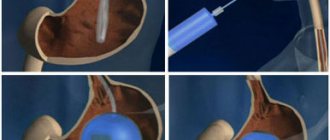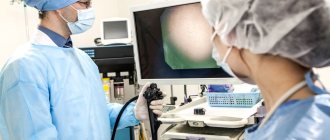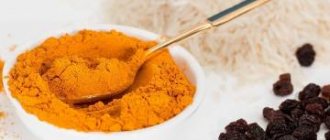Gastroscopy is one of the most informative methods for studying the condition of the gastrointestinal tract (its upper section), since this procedure allows you to visually assess the presence of damage to the gastric mucosa, the presence of polyps, erosions, ulcers, bleeding and other pathologies of the walls of the stomach and duodenum. Many patients are interested in the question of how safe this generally unpleasant procedure is, and how often gastroscopy can be done in the presence of various pathologies of the digestive tract.
The frequency of gastroscopy is determined by the attending physician.
However, this study is also prescribed for many other diseases. For example, cardiovascular: before performing a coronography, an endovascular cardiologist must ensure that there are no gastric erosions or ulcers. Otherwise, the operation will be postponed, since the patient on the eve of surgery must take strong antithrombotic drugs that thin the blood and promote bleeding.
Indications for gastroscopy
General symptoms such as nausea, diarrhea, vomiting do not always indicate the presence of diseases of the digestive tract, but if the patient complains, he will most likely be prescribed a series of tests that should confirm or refute suspicions of gastritis, duodenitis or other gastric pathologies.
Other indications for prescribing gastroscopy include the following:
- suspicion of the presence of malignant neoplasms in the stomach/esophagus;
- the need for constant monitoring of the condition of the gastric epithelium in the treatment of gastrointestinal diseases;
- symptoms of gastric bleeding;
- if a foreign object enters the stomach;
- if the patient often experiences pain in the epigastric region;
- difficulties experienced by the patient when eating;
- to clarify the diagnosis for a number of diseases not related to gastrointestinal pathologies.
FGDS should be prescribed with caution to children under six years of age, if there is a history of severe mental disorders, if the patient is diagnosed with exacerbation of chronic gastritis or gastric ulcer, or if there is a respiratory tract infection. In any case, the appointment of this procedure can occur repeatedly, and not knowing in what cases and how often gastroscopy of the stomach can be done is very worrying for many patients.
As for contraindications to the appointment of esophagogastroduodenoscopy (the official medical name for gastroscopy), there are few of them:
- some heart diseases;
- narrow compared to the standard entrance to the stomach;
- obesity 2 – 3 degrees;
- hypertension;
- kyphosis/scoliosis;
- a history of stroke/heart attack;
- congenital/acquired blood diseases.
How often can an FGDS of the stomach be done?
Fibrogastroduodenoscopy is a multitasking procedure. Depending on the type of gastroscopy, the procedure is performed at different intervals:
- diagnostic - despite the fact that gastroscopy can hardly be called a pleasant procedure, such a study is a highly accurate way to examine organs. FGDS is performed using a fiber-optic instrument, which is equipped with a camera that allows you to carefully examine the stomach and digestive organs. It is recommended to carry out diagnostic gastroscopy at least once every 3 years, and if there are patient complaints or if the development of gastrointestinal diseases is suspected, every year;
- therapeutic - specialists turn to the therapeutic form of FGDS in cases where the disease has already been identified and it is necessary to carry out therapeutic manipulations - removal of formations, cauterization of bleeding, spraying of special pharmaceuticals inside the gastrointestinal tract. How often gastroscopy of the stomach can be done solely for therapeutic purposes is determined only by a gastroenterologist;
- preventive – such gastroscopy is recommended for all patients with diseases of the digestive system. How often to carry out a preventive examination is determined by a specialist, on average from once every 6-12 months.
Note! Often, diagnostic FGDS is recommended for women planning to bear a child. Early examination allows the expectant mother to alleviate the effects of toxicosis in the first trimester of pregnancy and detect other pathologies.
Only a specialist can answer with complete confidence the question of how often a study should be carried out, based on the patient’s complaints, test results and medical history. In particular, re-examination concerns patients who have already been diagnosed with gastrointestinal disease.
For chronic gastritis
Chronic gastritis develops in patients as a result of constant exposure to various factors - chemical, physical, thermal and bacterial. For chronic gastritis, specialists prescribe treatment with pharmaceuticals.
To monitor the progress of the treatment and recovery processes, preventive gastroscopy is prescribed. How often an FGDS should be done is determined by a gastroenterologist; generally, with chronic gastritis, the patient is recommended to undergo checks every 6 months, since if left unchecked, the disease develops into a more severe form, namely peptic ulcer and even stomach cancer.
With atrophic gastritis
Atrophic gastritis is one of the forms of chronic gastritis, in which the death of cells responsible for the secretion of hydrochloric acid necessary for digestion occurs. As a result of pathological processes in atrophic gastritis, not only a deterioration in the process of food digestion occurs, but also a deficiency of vitamins, including vitamin B12.
How is gastroscopy performed?
An instrument that allows you to examine the condition of the inner walls of the stomach (and, if necessary, the duodenum) is a type of endoscope. A gastroscope consists of a hollow elastic tube containing a fiber-optic cable with an optical and illuminating device at the end. Through the mouth and esophagus, the hose is inserted into the stomach cavity for a thorough examination. Through the cable, the image is transmitted to the eyepiece or monitor screen, and the doctor conducting the study has the opportunity to study the condition of the epithelium in different parts of the stomach by turning and moving the tube in the desired direction.
Is gastroscopy harmful from the point of view of the condition of the esophagus and stomach walls in contact with a solid foreign object? Before the procedure, the gastroscope is thoroughly disinfected, so the likelihood of external infection is extremely low (no more than when eating fruits, bread or vegetables). The possibility of damaging the walls of the esophagus, stomach or duodenum is also close to zero, since the device in its basic form does not have sharp protrusions.
But the procedure itself requires compliance with certain restrictions on the part of the patient. First of all, it should be done on an empty stomach: the presence of food mass makes it very difficult to examine the mucous membrane, so it is very important not to eat 10 - 12 hours before gastroscopy. Approximately 100–120 minutes before the procedure, you should drink about 200 grams of liquid (weak tea or boiled water), which will clear the stomach walls of food debris and mucus. It is highly recommended to refrain from smoking the day before, as this provokes the secretion of gastric juice.
Immediately before insertion of the probe, the pharynx and upper part of the esophagus are anesthetized with a spray, and excessive anxiety is relieved with a subcutaneous injection of a mild sedative - the patient’s calm during the manipulation is very important, since fear can lead to involuntary sudden movements, which will make it difficult to examine the walls of the stomach.
Important: the shelf life of gastroscopy before surgery is one month, after which you will have to do a second examination (in a month, significant changes can occur in the stomach cavity, which can affect the result of the operation or be a direct contraindication to its implementation).
The gastroscopy itself is carried out in the following sequence:
- the patient undresses to the waist; if he has glasses or removable dentures that do not adhere well, they must also be removed;
- manipulation is carried out only in a lying position with a straight back, usually on the right side;
- a special mouthpiece is inserted into the mouth, which must be held firmly in order to prevent reflexive clenching of the teeth;
- after instructions to take a few sips and completely relax the larynx, the endoscope is inserted and lowered until it reaches the entrance to the stomach (the most unpleasant moment is the transition from the oral cavity to the esophagus, during which a natural urge to vomit occurs);
- then the doctor begins to turn the gastroscope, which allows you to examine the condition of the gastric cavities from all sides (the viewing angle of the device, as a rule, does not exceed 150 degrees).
How to prepare for the procedure
Preparation for the procedure has specific features. It is important that the procedure be carried out strictly on an empty stomach, because the food eaten will prevent you from seeing all the changes on the mucous membrane. Therefore, it is necessary not to eat or drink for at least 6 hours before the procedure, and it is also not recommended to smoke.
Content:
- How to prepare for the procedure
- Why do gastroscopy?
- Sedation and anesthesia
- Types of gastroscopy
- Gastroscopy and colonoscopy on the same day
- What happens during the procedure
- Side effects and complications of gastroscopy
- Gastroscopy in children
If there is still a need to drink water, for example, to wash down medications that the patient needs for life, then they can be taken with small sips of water, but after this you must inform the doctor conducting the study. Due to the fact that the procedure is performed on an empty stomach, patients are scheduled for examination in the first half of the day.
Patients with asthma are allowed to use the inhaler as directed. Smokers are advised not to smoke at least 6 hours before the procedure.
It is very important to inform the doctor 5 days before the gastroscopy about any medications the patient is taking, as the dose may need to be adjusted, or even completely stopped taking certain medications, such as iron supplements, antacids, antisecretory and blood thinners. You should discuss any allergies to medications, as well as underlying medical conditions such as heart or lung disease, with your doctor.
Diet before gastroscopy
On the eve of endoscopy, the diet should be as light as possible throughout the day; in the evening, a light dinner in the form of stewed vegetables with boiled chicken or fish. In this case, the serving is supposed to be no more than 350 grams. Next, fasting for 12 hours before the study, since during this time the stomach has time to fully digest and evacuate what has been eaten.
The volume drunk on an empty stomach should not exceed 300 ml. Large amounts of fluid may cause vomiting when the endoscope is inserted; You are only allowed to drink water, as other liquids can cause the production of hydrochloric acid.
If these conditions are met, nothing will interfere with the endoscopy.
Duration of the procedure
When performing a gastroscopy for diagnostic purposes, an experienced doctor only needs 12 to 15 minutes to examine the entire inner surface of the stomach, however, in some cases, a biopsy (taking a sample of epithelial tissue for laboratory testing) or other therapeutic manipulations (for example, administering medications) may be necessary. Such a comprehensive study can last up to 25–40 minutes.
For some time after the manipulation, the patient should be in a supine position; eating during gastroscopy without a biopsy is allowed after 60 minutes. If the procedure was carried out with a biopsy taken, the first meal of non-hot food is allowed after 180 - 240 minutes. If the procedure is performed on a child under 6 years of age or a patient with a history of mental disorders, gastroscopy can be performed under general anesthesia.
Decoding the results
The uninitiated will probably not be able to interpret the resulting images, since the resulting picture will more likely resemble some kind of fantastic landscape. But an experienced doctor is able to make an accurate diagnosis, guided by the method of comparison with mucous membranes without pathologies.
It looks like this:
- the color of the mucous membrane ranges from red to pale pink;
- even with an empty stomach, there is always a little mucus on the surface of the walls;
- the front wall looks smooth and shiny, and the back wall is covered with folds.
With gastritis, ulcers, and stomach cancer, deviations from the norm appear that neither x-rays nor ultrasound can detect. But gastroscopy will definitely reveal them: with gastritis, the disease will be indicated by an increased amount of mucus, swelling and redness of the epithelium, and local minor hemorrhages are possible. With an ulcer, the surface of the walls is covered with red spots, the edges of which have a whitish coating, indicating the presence of pus. With stomach cancer, the back wall of the stomach becomes smooth, and the color of the mucous membrane changes to light gray.
How often can a gastroscopy be done?
In life, there are often situations when we do not attach importance to certain symptoms that indicate the presence of pathology, and when a diagnosis is made, we begin to intensively look for ways to get rid of it, undergoing consultations and examinations with different specialists. In the case of gastritis, no doctor will undertake treatment without receiving accurate information about the condition of the mucous membrane. And there are often cases when, after undergoing a gastroscopy, a new specialist may refer the patient for a re-examination to make sure that no significant changes have occurred over time. Therefore, many patients are interested in how long it will take to repeat gastroscopy.
In principle, in the absence of contraindications, the number of such manipulations is not limited, but in practice they try not to prescribe a test more than once a month - this is the shelf life of the results of the previous study. In the chronic course of the disease, in order to prevent complications (peptic ulcer, oncology), this study is prescribed 2–3 times a year. In the process of treating gastritis, if the actual effect of drug therapy does not coincide with the expected one, gastroscopy can be performed more often.
How often can gastroscopy of the stomach be done for preventive and therapeutic purposes?
Gastroscopy (FGDS) is a minimally invasive study, thanks to which a specialist can carefully examine the condition of the tissues of internal organs, namely the stomach, esophagus and duodenum. As a result of gastroscopy, the doctor has the opportunity to identify at the early stages a number of diseases of the digestive tract - gastritis, ulcerative processes, esophagitis, benign and malignant formations.
The main question that interests patients, how often can an FGDS of the stomach be done and whether this examination is harmful to the body, is described in detail in this article.











